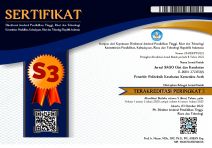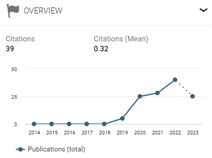Pengaruh intervensi pemberian makanan tambahan (PMT) berbasis menu lokal terhadap wasting pada balita di Sukoharjo
DOI: 10.30867/gikes.v6i1.2279Abstract
Background: Supplementary feeding (PMT) is one of the interventions aimed at reducing the incidence of wasting among toddlers. The macronutrient content in PMT plays a role in improving toddlers' weight, thereby potentially reducing wasting rates.
Objective: To determine the effect of PMT in reducing wasting rates among toddlers.
Methods: This study used a pre-and-post design without a control group, involving 35 subjects selected through a multistage random sampling method. The intervention was conducted over 90 days from January to March 2024, using a 10-day menu cycle. Data on wasting toddlers were obtained from secondary data provided by the Sukoharjo District Health Office, measured using the Weight-for-Height (WHZ) indicator and analyzed using WHO Anthro. A wasting child is defined as having a WHZ score between -3 SD and <-2 SD, while severe wasting is defined as a WHZ score <-3 SD. Data analysis employed the Wilcoxon test for non-normally distributed data.
Results: The study showed that the average WHZ score of toddlers before PMT was -2,4 SD, improving to -1,8 SD after the intervention. PMT increased the nutritional status of wasting and severely wasting toddlers to normal in 57,1% of cases. A significant difference was observed in the nutritional status of toddlers before and after PMT (P = 0,001).
Conclusion: PMT is proven effective in reducing the prevalence of wasting among toddlers.
Keywords
Full Text:
PDFReferences
Abdillah, Fajar., et al. (2022). The effectiveness of supplementary feeding on the nutritional status of Puskesmas Citeras Garut Regency. Nutrition Scientific Journal, I(1), 30–40. https://doi.org/10.37058/nsj.v1i1.5975
Amalia, Nur., et al. (2023). Ketahanan pangan terhadap stunting dan wasting pada anak: A Systematic Review. Syntax Literate, 8(12), 6711–6726.
Andrianto, N., et al. (2024). Edukasi pentingnya kapasitas kader posyandu dalam pencegahan stunting dan gizi buruk melalui “SEDULUR SEHAT” di Desa Pupasari. In Communnity Development Journal (Vol. 5, Issue 6).
Boah, M., et al. (2019). The epidemiology of undernutrition and its determinants in children under five years in Ghana. PLoS ONE, 14(7). https://doi.org/10.1371/journal.pone.0219665
Chabibah, N., et al. (2023). Effect of intervention of soy milk fortified with moringa leaf powder on improving nutritional status. Amerta Nutrotion, 7(2), 210–216.
Chowdhury, T. R., et al. (2020). Factors associated with stunting and wasting in children under 2 years in Bangladesh. Heliyon, 6(9). https://doi.org/10.1016/j.heliyon.2020.e04849
Das, S., et al. (2020). Dietary magnesium, vitamin d, and animal protein intake and their association to the linear growth trajectory of children from birth to 24 months of age: Results From MAL-ED Birth Cohort Study Conducted in Dhaka, Bangladesh. Food and Nutrition Bulletin, 41(2), 200–210.
https://doi.org/10.1177/0379572119892408
De Groot, R., et al. (2017). Cash transfers and child nutrition: Pathways and Impacts. Development Policy Review, 35(5), 621–643. https://doi.org/10.1111/dpr.12255
Denney, J. T., et al. (2020). Food insecurity in households with young children: A test of contextual congruence. Social Science and Medicine, 263. https://doi.org/10.1016/j.socscimed.2020.113275
Dinas Kesehatan kabupaten Sukoharjo. (2021). Profil Kesehatan Kabupaten Sukoharjo 2021.
Dinas Kesehatan Kabupaten Sukoharjo. (2022). Profil Kesehatan Kabupaten Sukoharjo 2022.
Djakiyah., et al. (2024). Pengaruh pendapatan dan kebutuhan terhadap pola konsumai masyarakat pada Kecamatan Alam Barajo Kota Jambi. Jurnal Pendidikan Tambusi, 8(1), 6741–6752.
Dipasquale, V., et al. (2020). Acute malnutrition in children: Pathophysiology, clinical effects and treatment. In Nutrients (Vol. 12, Issue 8, pp. 1–9). MDPI AG. https://doi.org/10.3390/nu12082413
EFSA. (2017). Dietary reference values for nutrients summary report. EFSA Supporting Publications, 14(12). https://doi.org/10.2903/sp.efsa.2017.e15121
Eshete, H., et al. (2017). Nutritional status and effect of maternal employment among children aged 6-59 months in Wolayta Sodo Town, Southern Ethiopia: A Cross-sectional Study. Ethiopian Journal of Health Sciences, 27(2), 155–162. https://doi.org/10.4314/ejhs.v27i2.8
Hasan, M. M., et al. (2023). Association of access to water, sanitation and handwashing facilities with undernutrition of children below 5 years of age in Bangladesh: Evidence from two population-based, nationally representative surveys. BMJ Open, 13(6). https://doi.org/10.1136/bmjopen-2022-065330
Hidayat, W., et al. (2025). Penyuluhan kawasan rumah tangga tanpa asap rokok bagi kelompok ibu ibu pkk rw 01 Kelurahan Tlogomas Kota Malang. In Jurnal of Economic and Social Empowerment (Vol. 5, Issue 1).
Kang, Y., & Kim, J. (2019). Risk factors for undernutrition among children 0–59 months of age in Myanmar. Maternal and Child Nutrition, 15(4). https://doi.org/10.1111/mcn.12821
Kassaw, A., et al. (2024). Wasting and its associated factors among under-two years children in Ethiopia: a systematic review and meta-analysis. BMC Public Health, 24(1). https://doi.org/10.1186/s12889-024-20063-1
Kemenkes. (2020a). Buku saku pencegahan dan tata laksana gizi buruk pada balita di Layanan Rawat Jalan Bagi Kesehatan.
Kemenkes. (2020b). Bunga rampai wasting bencana bagi sumber daya mnusia tantangan indonesia maju tahun 2045.
Kemenkes. (2023a). Petunjuk teknis pemberian makanan tambahan (pmt) berbahan pangan lokal untuk balita dan ibu hamil 2023 613.2 Ind p.
Kemenkes. (2023b). Survei Kesehatan Indonesia (SKI).
Lemoine, A., & Tounian, P. (2020). Childhood anemia and iron deficiency in sub-Saharan Africa–risk factors and prevention: A review. Archives de Pédiatrie, 27(8), 490-496.
Luby, S. P., et al. (2018). Effects of water quality, sanitation, handwashing, and nutritional interventions on diarrhoea and child growth in rural Bangladesh: a cluster randomised controlled trial. The Lancet Global Health, 6(3), e302–e315. https://doi.org/10.1016/S2214-109X(17)30490-4
Mentari, M., et al. (2023). Determinan kejadian wasting pada balita di Provinsi Aceh tahun 2021 (Determinant of wasting incidents in children of age 0-59 months in Aceh Province on 2021). Seminar Nasional Official Statistics, 321–330.
Mohamed, Ahmed., et al. (2023). Exclusive breastfeeding: Impact on infant health. Clinical Nutrition Open Science, 51, 44–51. https://doi.org/10.1016/j.nutos.2023.08.003
Saenong, et al. (2024). The relationship between cigarette smoke exposure and stunting among children in the working area of the Pangkajene Health Center, Sidrap Regency in 2023. Journal Of Nursing Practice, 7(2), 325–334. https://doi.org/10.30994/jnp.v7i2.466
Mushollini, F., et al. (2023). Differences in food intake (energy, protein, fat and carbohydrates) in child wasting by giving cookies of purple sweet potato and tempeh flour. Journal FKM UMJ, III(1), 2023. http://e-journal.fkmumj.ac.id/
Nadhiroh, S. R., et al. (2020). The association between secondhand smoke exposure and growth outcomes of children: A systematic literature review. In Tobacco Induced Diseases (Vol. 18). International Society for the Prevention of Tobacco Induced Diseases. https://doi.org/10.18332/tid/117958
Noviana Sari, E. (2022). Faktor-faktor yang mempengaruhi kejadian wasting pada balita umur 1-5 tahun. Jurnal Kesehatan Poltekkes Kemenkes Ri Pangkalpinang, 10(1).
Papotot, G. S., et al. (2021). Pengaruh kekurangan nutrisi terhadap perkembangan sistem saraf anak. Jurnal Biomedik: JBM, 13(3), 266. https://doi.org/10.35790/jbm.13.3.2021.31830
Penugonda, A. J., et al. G. (2022). Impact of exclusive breast feeding until six months of age on common illnesses: A prospective observational study. Journal of Family Medicine and Primary Care, 11(4), 1482–1488. https://doi.org/10.4103/jfmpc.jfmpc_1423_21
Purbaningsih, et al. (2023). Efektivitas pemberian makanan tambahan (PMT) berbahan pangan lokal terhadap kenaikan berat badan balita. Media Publikasi Promosi Kesehatan Indonesia (MPPKI), 6(12), 2550–2554. https://doi.org/10.56338/mppki.v6i12.4206
Qasrawi, R., et al. (2024). Machine learning approach for predicting the impact of food insecurity on nutrient consumption and malnutrition in children aged 6 months to 5 years. Children, 11(7). https://doi.org/10.3390/children11070810
Rahmadani, R. A., et al. (2023). Socioeconomic factors with nutritional status of toddlers. Jurnal Ilmiah Kesehatan Sandi Husada, 12(2), 445–451. https://doi.org/10.35816/jiskh.v12i2.1115
Sahiledengle, B., et al. (2024). Childhood undernutrition mediates the relationship between open defecation with anemia among Ethiopian children: a nationally representative cross-sectional study. BMC Public Health, 24(1). https://doi.org/10.1186/s12889-024-18931-x
Sari.Y, & Maringga. (2022). Faktor biologis dan sosial yang berpengaruh terhadap kejadian wasting pada balita. Jurnal Ilmu Kesehatan Masyarakat, 11(06), 511–519. https://doi.org/10.33221/jikm.v11i06.1884
Savarino, G., et al. (2021). Macronutrient balance and micronutrient amounts through growth and development. In Italian Journal of Pediatrics (Vol. 47, Issue 1). BioMed Central Ltd. https://doi.org/10.1186/s13052-021-01061-0
Sawe, C., & Keino, S. (2022). Tripartite of malnutrition: co-existence of underweight, overweight and micronutrient deficiency among children in Kisumu County, Kenya. Community and Public Health Nutrition, 171.
https://academic.oup.com/cdn/article/6/Supplement_1/171/6606666.
Sholikah, A., et al. (2017). Faktor-faktor yang berhubungan dengan status gizi balita di pedesaan dan perkotaan. In Public Health Perspective Journal (Vol. 2, Issue 1). http://journal.unnes.ac.id/sju/index.php/phpj
Soedarsono, et al,. (2021). Faktor yang mempengaruhi kejadian wasting pada balita di Wilayah Kerja Puskesmas Simomulyo Surabaya. Media Gizi Kesmas, 10(02), 237–245.
Suryana, et al. (2024). Relationship between macro- and micronutrient intakes with undernutrition among toddlers aged 12–23 months in Aceh, Indonesia. Malaysian Journal of Nutrition, 30(2), 217–229. https://doi.org/10.31246/mjn-2023-0118
Syarfaini, S., et al. (2022). Hubungan asupan zat gizi makro terhadap kejadian wasting pada balita usia 0-59 bulan di Kecamatan Polombangkeng Utara Kabupaten Takalar Tahun 2022. Ghidza: Jurnal Gizi Dan Kesehatan, 6(2), 128–138. https://doi.org/10.22487/ghidza.v6i2.524
WHO. (2023). Levels and trends in child malnutrition.
Wu, G. (2016). Dietary protein intake and human health. In Food and Function (Vol. 7, Issue 3, pp. 1251–1265). Royal Society of Chemistry. https://doi.org/10.1039/c5fo01530h
Yanti, E. S. (2021). Dukungan ayah asi terhadap keberhasilan asi eksklusif. Muhammadiyah Journal of Midwifery, 1(2), 67. https://doi.org/10.24853/myjm.1.2.67-74
Zuhkrina, Y., et al. (2021). Pengaruh pendapatan dan riwayat BBLR terhadap status gizi balita di Wilayah Kerja Puskesmas Kota Sigli Kabupaten Pidie Tahun 2021. In Jurnal Aceh Medika (Vol. 5, Issue 2). http://jurnal.abulyatama.ac.id/index.php/acehmedika.
Refbacks
- There are currently no refbacks.














